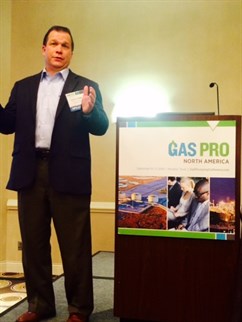GasPro ’14: Gas/electric-driven compression cuts emissions, costs
 By Adrienne Blume
By Adrienne Blume
Managing Editor
HOUSTON -- On Day 2 of the inaugural GasPro North America conference, David Coker, vice president of Energy Transfer Technologies (ETT), spoke about natural gas compression choices.
Traditional gas compression is driven by either natural gas or electricity. The advantages of natural gas-driven compression are fuel availability and reliability, although emissions are a problem.
Electric-driven compression is characterized by the benefits of emissions reduction and lower maintenance costs. Disadvantages include reliability concerns, infrastructure construction lead time and peak demand power prices.
A third choice exists: duel-drive technology, which combines natural gas and electricity to power gas compressors. Duel-drive technology is an energy management tool that pays for itself, Mr. Coker said.
The benefits of duel-drive technology include easy emissions management, with permitting structured according to how long the compressor motor must be run. This results in significant emissions reduction.
The technology also mitigates interconnect delays and optimizes fuel choice by offering a seamless transfer between electricity and gas fuel.
The technology has been applied to a large plant in Jackson, Texas, that started up in late 2012.
The original design involved all electric-driven compression, but ETT's study showed that the use of duel-drive technology is an excellent way to optimize compression operations.

- Gasum powers Equinor's platform supply vessel with bio-LNG
- ADNOC deploys pioneering AI-enabled process optimization technology
- Mexico Pacific announces long-term LNG SPA with POSCO International
- ONEOK to acquire Medallion and controlling interest in EnLink for $5.9 B
- Golar LNG signs EPC deal for $2.2-B MK II FLNG conversion project



Comments